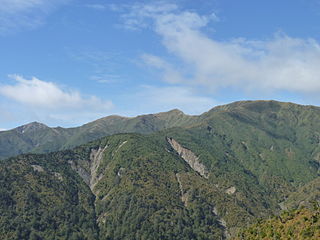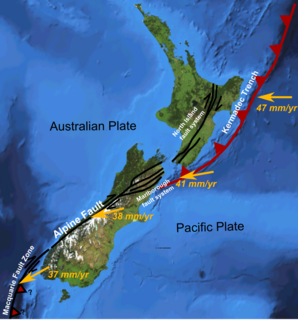
Palmerston North is a city in the North Island of New Zealand and the seat of the Manawatū-Whanganui region. Located in the eastern Manawatu Plains, the city is near the north bank of the Manawatu River, 35 km (22 mi) from the river's mouth, and 12 km (7 mi) from the end of the Manawatu Gorge, about 140 km (87 mi) north of the capital, Wellington. Palmerston North is the country's eighth-largest urban area, with an urban population of 81,500.

SS Elingamite was an Australian passenger steamer of 2,585 tons, built in 1887, and owned by Huddart Parker. The ship was wrecked on 9 November 1902 off the north coast of New Zealand carrying a large consignment of gold. Now the Elingamite wreck is a favourite site for adventurous divers because of the drama associated with it, and wild tales of lost treasure.

The New Zealand general election of 1972 was held on 25 November to elect MPs to the 37th session of the New Zealand Parliament. The Labour Party, led by Norman Kirk, defeated the governing National Party.

The Ruahine Range is the largest of several mountain ranges in the North Island of New Zealand that form a ridge running parallel with the east coast of the island between East Cape and Wellington. The ridge is at its most pronounced from the central North Island down to Wellington, where it comprises the Ruahine, Tararua and Remutaka Ranges.

TSS Kanowna, was an Australian steamer built during 1902. The 6,993-ton, 126-metre (413 ft) long Kanowna was constructed by William Denny and Brothers of Dumbarton, Scotland, and had a twin screw design.

CP Ships was a large Canadian shipping company established in the 19th century. From the late 1880s until after World War II, the company was Canada's largest operator of Atlantic and Pacific steamships. Many immigrants travelled on CP ships from Europe to Canada. The sinking of the steamship RMS Empress of Ireland just before World War I was the largest maritime disaster in Canadian history. The company provided Canadian Merchant Navy vessels in World Wars I and II. Twelve vessels were lost due to enemy action in World War II including the largest ship sunk by a German U-boat, RMS Empress of Britain.
The Rangitikei by-election of 1978 was a by-election in the New Zealand electorate of Rangitikei, a predominantly rural district in the middle of New Zealand's North Island. The by-election occurred on 18 February 1978, and was precipitated by the death of sitting National Party member of parliament Sir Roy Jack in December 1977.

SS Ionic was a steam-powered ocean liner built in 1902 by Harland and Wolff in Belfast for the White Star Line. She was the second White Star Liner to be named Ionic and served on the United Kingdom – New Zealand route. Her sister ships were SS Athenic and SS Corinthic.

Talune has been the name of three vessels. This article refers to the first SS Talune, built in 1890 and scuttled in 1925.

SS Prinz Friedrich Wilhelm was an ocean liner for North German Lloyd (NDL) from her launch in 1907 until the end of World War I. After the war, she briefly served as USS Prinz Friedrich Wilhelm (ID-4063) for the United States Navy returning American troops from France. The vessel was first chartered—and later purchased outright—by Canadian Pacific Steamships (CP) and operated under the names Empress of China, Empress of India, Montlaurier, Monteith, and Montnairn. She was scrapped in 1929.
Ruahine is a former New Zealand parliamentary electorate, from 1972 to 1978.
The Wellington Region of New Zealand has a foundation of Torlesse Greywacke rocks, that make up the Tararua and Rimutaka Ranges, that go from Wellington in the south to the Manawatu Gorge, where they are renamed as the Ruahine Ranges, and continue further north-northeast, towards East Cape. To the west of the Tararua Ranges are the Manawatu coastal plains. To the east of the Ruahine Ranges is the Wairarapa-Masterton Basin, then the Eastern Uplands that border the eastern coast of the North Island from Cape Palliser to Napier.
Oroua was a parliamentary electorate in the Manawatū-Whanganui region of New Zealand from 1902 to 1938.

The North Island Fault System or North Island Dextral Fault Belt is a set of southwest–northeast trending seismically-active faults in the North Island of New Zealand that carry most of the dextral strike-slip component of the oblique convergence of the Pacific Plate with the Australian Plate. They include the Wairarapa Fault and Wellington Fault to the southwest, the Ruahine and Mohaka Faults in the central section and the Waimana, Waiotahi, Whakatane and Waiohau Faults to the northeast. Most of the fault system consists of dextral strike-slip faults, although towards its northeastern end the trend swings to more S-N trend and the faults become mainly oblique normal in sense as the zone intersects with the Taupo rift zone. This fault zone accommodates up to 10 mm/yr of strike-slip displacement.

The Wellington Fault is an active seismic fault in the southern part of the North Island of New Zealand. It is a dextral (right-lateral) strike-slip fault with variable amounts of vertical movement causing uplift to the northwest, as expressed by a series of ranges. It forms part of the North Island Fault System, which accommodates the transfer of displacement along the oblique convergent boundary between the Indo-Australian Plate and Pacific Plate.

SS Athenic was a British passenger liner built by Harland & Wolff shipyards for the White Star Line in 1901. In 1928, she came to a Norwegian company and was renamed SS Pelagos. Torpedoed in 1944, she was refloated the following year and continued to serve until her demolition in 1962.

SS Oceana was a P&O passenger liner and cargo vessel, built in 1888 by Harland and Wolff of Belfast. Originally assigned to carry passengers and mail between London and Australia, she was later assigned to routes between London and British India. On 16 March 1912 the ship collided in the Strait of Dover with the Pisagua, a 2,850 GRT German-registered four-masted steel-hulled barque. As a result Oceana sank off Beachy Head on the East Sussex coast, with the loss of 17 lives.
The following index is provided as an overview of and topical guide to recreational dive sites:
SS Ruahine was a UK-built ocean liner and refrigreated cargo ship. She was launched in 1909 in Scotland for the New Zealand Shipping Company, who operated her in scheduled service between Britain and New Zealand. She survived both World wars.

MS Ruahine was a passenger ship that operated in the mid-20th century, primarily for the New Zealand Shipping Company.













